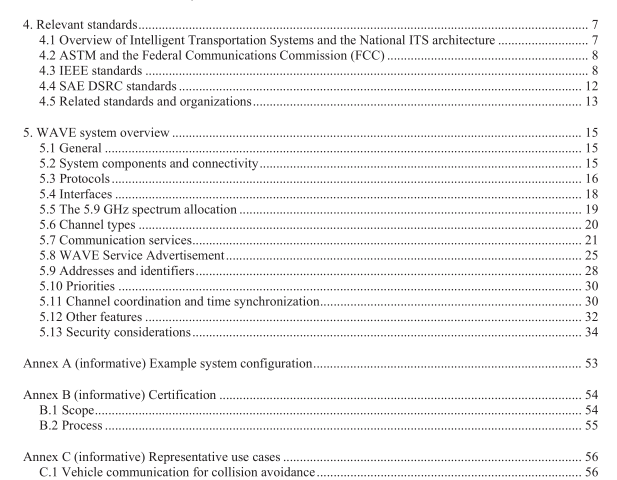IEEE 1609.0-2013 pdf download.IEEE Guide for Wireless Access in Vehicular Environments (WAVE) Architecture
1.1 Scope
his guide describes the architecture and operation of a WAVE system based on IEEE 1609 standards and IEEE Std 802.11-2012.
1.2 Aspects of a WAVE system
1.2.1 Introduction
ISO/IEC 42010:2007 [B28] is a recommended practice for architectural description of software-intensive systems, and defines several aspects of any system: an environment or context, stakeholders who typically have interest in or concerns relative to the system, and one or more missions. These aspects are addressed in 1.2.2 through 1.2.5.
1.2.2 Environment
As its name suggests, the WAVE system as presently envisaged is designed to meet the communication needs of mobile elements in the transportation sector. While in many of the usage scenarios at least one of the devices engaged in WAVE communications is expected to be associated with a vehicle, other devices, both fixed and portable (e.g., roadside and pedestrian) are envisaged as well.
1.2.3 Stakeholders
This document is intended to be a useful reference for any of the direct stakeholders including the following:
⎯ Government agencies, e.g., national and state road operators.
⎯ Vehicle designers and original equipment manufacturers.
⎯ Aftermarket equipment makers.
⎯ Developers of applications and related standards. Indirect stakeholders include anyone who uses or is otherwise affected by the intelligent transportation systems built using the WAVE standards.
1.2.4 Mission
The WAVE standards enable the development of interoperable low-latency, low overhead WAVE devices that can provide communications in support of transportation safety, efficiency and sustainability, and that can enhance user comfort and convenience.
1.2.5 Views This document presents several architectural representations, or views. These include a device view (see, e.g., 4.3.3.2 and 4.3.3.3), a protocol view (see, e.g., 5.3.1), and a standards view (see, e.g., 4.3.3.1). 2. Normative references The following referenced documents are indispensable for the application of this document (i.e., they must be understood and used, so each referenced document is cited in text and its relationship to this document is explained).
For dated references, only the edition cited applies. For undated references, the latest edition of the referenced document (including any amendments or corrigenda) applies. Additional, non-essential references may be found in the bibliography in Annex G.
IEEE Std 802.11-2012, IEEE Standard for Information technology—Telecommunications and information exchange between systems—Local and metropolitan area networks—Specific requirements—Part 11: Wireless LAN Medium Access Control (MAC) and Physical Layer (PHY) specifications. 4, 5
IEEE Std 1609.2-2013, IEEE Standard for Wireless Access in Vehicular Environments (WAVE)—Security Services for Applications and Management Messages. IEEE Std 1609.3-2010, IEEE Standard for Wireless Access in Vehicular Environments (WAVE)— Networking Services.
IEEE Std 1609.4-2010, IEEE Standard for Wireless Access in Vehicular Environments (WAVE)—Multi- Channel Operation.
IEEE Std 1609.11-2010, IEEE Standard for Wireless Access in Vehicular Environments (WAVE)—Over- the-Air Electronic Payment Data Exchange Protocol for Intelligent Transportation Systems (ITS).
IEEE Std 1609.12, IEEE Standard for Wireless Access in Vehicular Environments (WAVE)—Identifier Allocations. SAE J2735-2009, Dedicated Short Range Communications (DSRC) Message Set Dictionary.
3. Definitions, abbreviation, and acronyms
3.1 Definitions
For the purposes of this document, the following terms and definitions apply. The IEEE Standards Dictionary Online or IEEE Std 802.11-2012 should be consulted for terms not defined in this clause. 7 advertised application-service opportunity: A resource consisting of a service channel (SCH) within geographic and temporal bounds, intended for support of an application-service as indicated by the transmission of a WAVE Service Advertisement (WSA) with Service Info and Channel Info referring to that application-service and SCH.
application: A higher layer entity that may make use of WAVE communication facilities.
application-service: A service, involving an exchange of data, generally provided by a higher layer entity on one WAVE device to a similar entity on another WAVE device, using WAVE communications.
certificate authority (CA): An authority trusted to issue digital certificates.IEEE 1609.0 pdf download.IEEE 1609.0-2013 pdf download
IEEE 1609.0-2013 pdf download

Leave a Reply